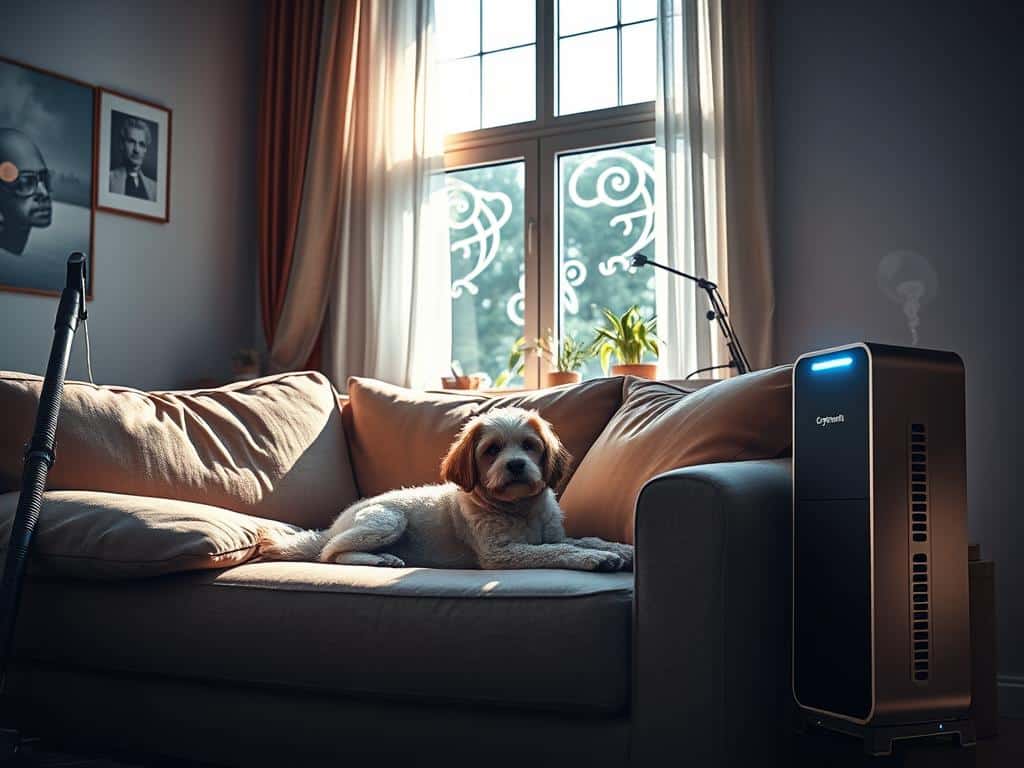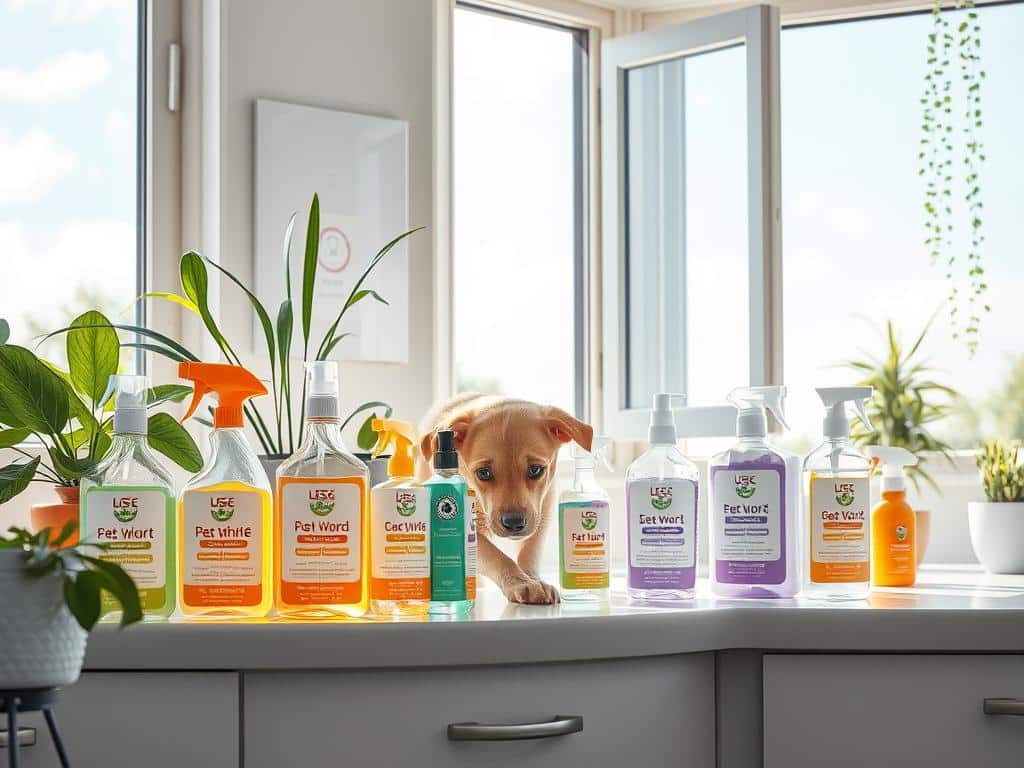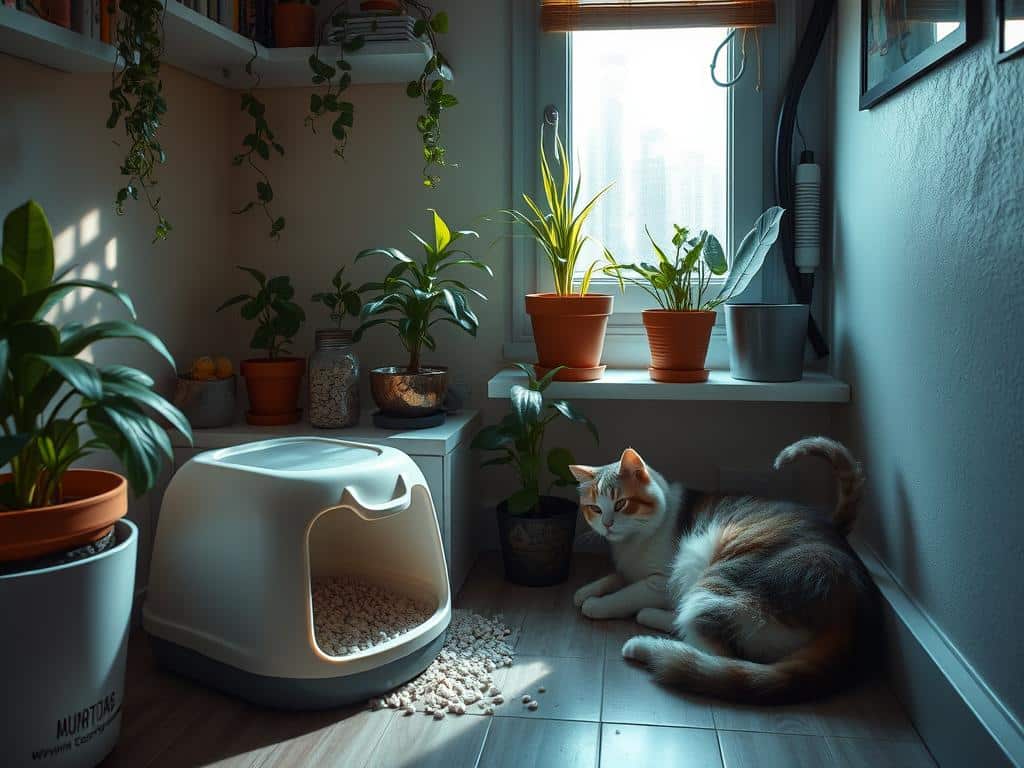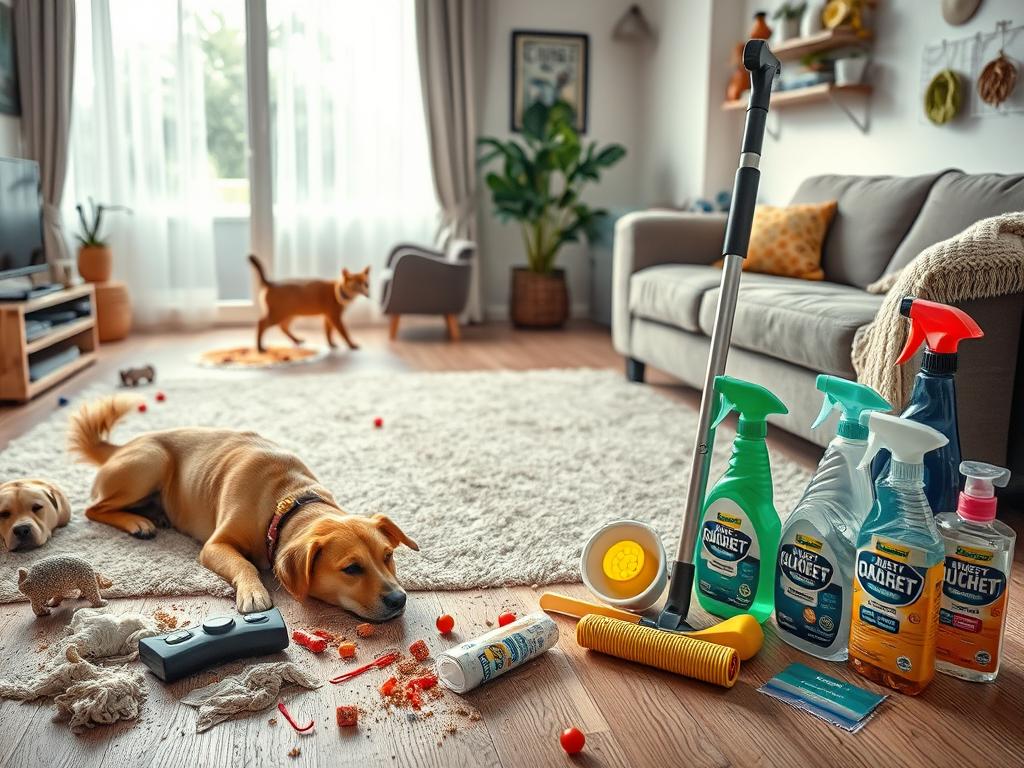
When you’re allergic to pets, it’s not just the fur you’re battling. You’re facing issues with dander, saliva, and pee proteins. These can lead to mild or extreme symptoms, like eye itchiness, sneezes, or difficulty breathing. However, certain actions can help lower dander and make your home allergy-friendly, easing your discomfort.
It’s smart to keep pets out of your bedroom since we spend much of our time there. For cleaner air, use bedding that resists allergens, clean often, and put HEPA filters in your heating and cooling system. These filters grab tiny particles, improving air quality. Also, dust regularly and choose flooring that’s easy to clean to avoid allergen build-up. By following these suggestions, you’ll make your home a better place for everyone, pets included.
Understanding Pet Allergies
Dealing with pet allergies can be hard. It’s key to know the causes, spot the symptoms, and understand allergen testing. This helps in managing allergies better.
What Causes Pet Allergies?
Pet allergies usually come from proteins in an animal’s dander, saliva, and urine. It’s not the hair causing the issue. These allergens are found in homes with pets. A 2018 study showed dog and cat allergens in almost all U.S. homes. This was true even in homes without pets.
Common Symptoms of Pet Allergies
Allergy signs can be different for everyone. People may have itchy eyes, a rash, or trouble breathing. Pets might itch, sneeze, or have ear problems. Being around pets can make asthma or wheezing worse for some people.
Importance of Allergen Testing
To manage pet allergies well, one must find the exact cause. This means getting tested by an allergist. The tests might include skin and blood tests or trying a special diet. Seeing an allergist can tell if the allergy is from pets or something else. Good testing leads to the best treatment plan.
Create an Allergen-Free Zone
Making your bedroom allergen-free is crucial for lessening pet allergy symptoms. Much time is spent in this space, after all. The aim is to cut down on pet dander exposure to keep your home’s air healthy.
Pet-Free Bedrooms
Keeping pets out of bedrooms is an effective allergy management step. Pet dander can lead to sneezing, itchy eyes, and breathing problems. So, this zone must be pet-free. Allergen-resistant bedding adds a big layer of defense.
Also, using a HEPA air purifier in the bedroom captures airborne allergens. This ensures the air stays clean and easy to breathe.

Clean the bedroom often using a vacuum with HEPA filters. These filters grab tiny particles, like pet dander, that normal vacuums can’t. A clean bedroom becomes a sanctuary, offering restful nights and refreshing mornings.
HEPA Filters and Ventilation
HEPA air purifiers excel at trapping small pet dander particles. They dramatically improve air quality. Using HEPA filters in your HVAC system filters the air in your entire home. This is key for bedrooms and common areas alike.
Good ventilation is also crucial. Open windows and use exhaust fans to keep air moving. This reduces pet allergens in your home.
Pairing good ventilation with HEPA air purifiers lessens allergen accumulation. This means allergy sufferers can breathe easier and feel more comfortable.
There are many ways to handle pet allergies. For more tips, check out this guide on living with pet allergies. It’s full of useful information.
Regular Pet Grooming and Bathing
Grooming and bathing your pet regularly is key to managing allergens at home. It greatly reduces allergens, making life more comfortable for both pets and their allergic owners. It helps in removing loose fur and dander.
Benefits of Regular Pet Grooming
Regular grooming is vital for your pet’s health and happiness. Brushing your pet every week spreads natural oils across their coat. This improves coat health and lessens shedding.
Using hypoallergenic shampoo every two weeks is advised by vets to keep skin healthy and reduce dander. Omega-3 and Omega-6 in fish oil help improve skin and reduce inflammation. Places like Paw Oasis Pet Resort & Spa offer gentle, hypoallergenic grooming for sensitive pets.
Choosing Hypoallergenic Pet Shampoos
Choosing the right hypoallergenic shampoo is crucial for reducing dander. These shampoos are soft on your pet’s skin and prevent dryness. They also soothe skin that’s prone to allergies.
Ask your vet for shampoo advice and how often to bathe your pet. Regular vet visits help in picking products for your pet’s health and keeping track of allergy management.
Doing grooming tasks outside or in areas with lots of air helps keep allergens down in your home. Grooming regularly is not just about allergens; it also strengthens your bond with your pet. It makes grooming a happy time for both of you.
Cleaning and Dusting Regularly
Keeping a regular cleaning schedule is key to managing pet allergies well. By tackling allergens like pet dander and dust often, you make the air cleaner for everyone. It’s important to vacuum and dust frequently to keep allergen levels low in your space.
Using a Pet-Specific Vacuum
A vacuum made for pets, with HEPA filters, can greatly help with pet allergies. These vacuums catch pet hair and dander better than regular vacuums. A HEPA filter traps tiny particles so they won’t spread in your home’s air.
Cleaning carpets and furniture every week is a good plan. HEPA filters work best in homes with pets. They pick up more dust and dander. Focus your dusting on places where your pets hang out the most. Use microfiber cloths—they catch more dust.
Frequency of Cleaning
For managing pet allergies, a routine cleaning schedule is critical. Clean weekly—vacuum carpets, wash pet beds, and dust. Sometimes, you might need to clean more often, especially where foot traffic is heavy or during allergy season. Dusting with damp cloths helps keep dander down, avoiding sneezes and itchy eyes.
Picking furniture that’s easy to clean, like leather, helps too. It holds fewer allergens than fabric does. Making these habits usual in your cleaning can keep your home more free from allergens.
Invest in Air Purifiers and HEPA Filters
Air purifiers and HEPA filters help a lot with pet allergies. They catch up to 99.97% of tiny airborne things, like pet dander. This makes the air indoors cleaner. A study in the Yonsei Medical Journal in August 2020 shows HEPA filters in purifiers make indoor air better. This can make allergy symptoms less severe and reduce the need for medicine.
The Rabbit Air A3 is a top choice for pet owners. It does really well in tests, earning a perfect score. It gets rid of pet hair, smells, and smoke. The Clorox air purifier is also great, catching 99.9% of bacteria and viruses. It’s good for rooms up to 1,000 square feet. The Alen BreatheSmart Air Purifier can clean air in big spaces, up to 1,400 square feet, every half hour.
When picking an air purifier, think about the room size it can cover and its clean air rate (CADR). A good CADR is at least 200, but 350 is better for bigger areas. The Medify Air Purifier is top-notch, covering up to 4,450 square feet. It has a dual HEPA filter that catches really tiny particles. Putting air purifiers in bedrooms and living spaces means you breathe cleaner air. This reduces the effects of pet allergens at home. For tips on keeping your indoor air clean, read this air duct cleaning guide.



